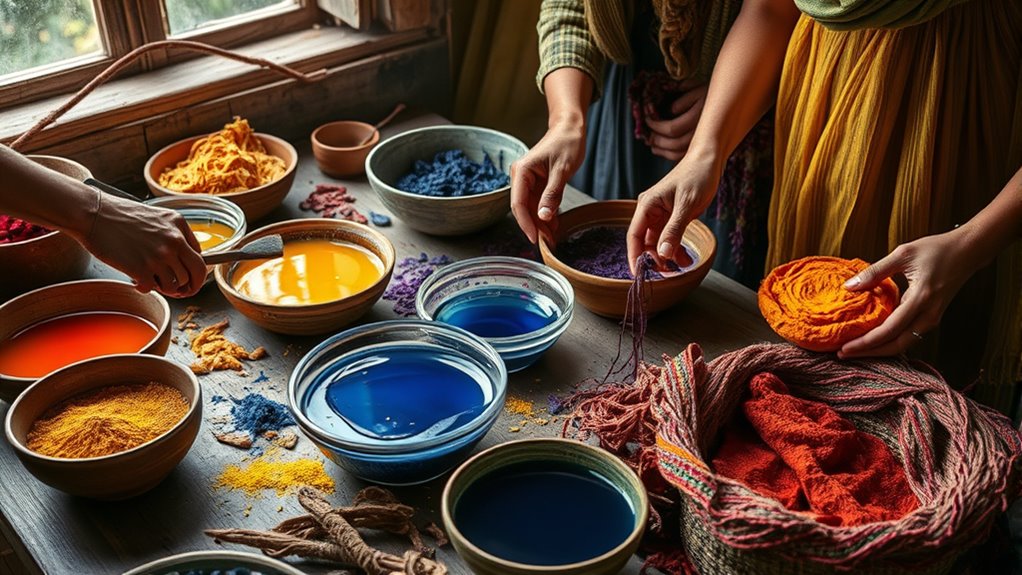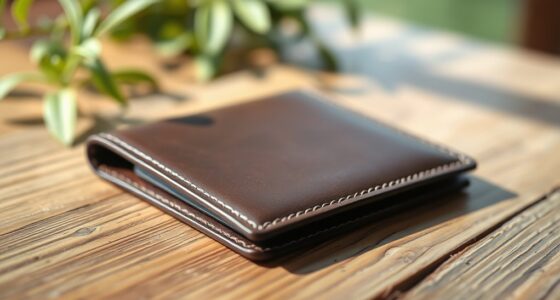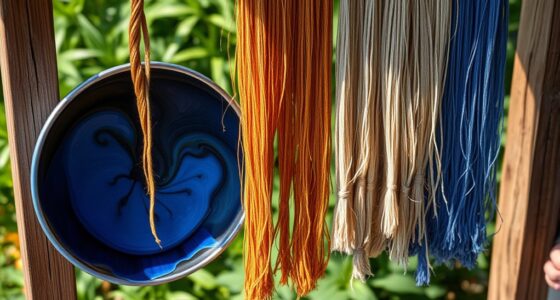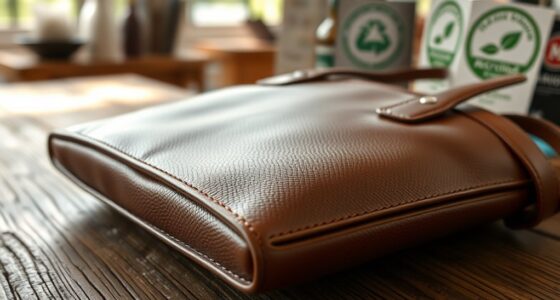Sustainable dyeing techniques are transforming the accessory industry by using eco-friendly methods like natural dyes from plants and herbs, waterless dyeing technologies, and mineral-based pigments. Recycled materials, microbial dye production, and precise digital processes also reduce waste and resource consumption. Closed-loop systems further minimize pollution, while collaborations drive innovative solutions. These approaches help create beautiful, durable accessories with less environmental impact—learn more about these game-changing practices and how they’re shaping a greener future.
Key Takeaways
- Natural dyes from plants and herbs offer eco-friendly, vibrant colors without harmful chemicals, transforming accessory aesthetics sustainably.
- Waterless dyeing technologies like vapor and digital printing drastically reduce water use and waste in accessory production.
- Recycled and upcycled textile materials enable sustainable dyeing, minimizing environmental impact and promoting innovative accessory designs.
- Mineral-based and clay dyes provide durable, long-lasting colors with minimal water and chemical use, enhancing accessory longevity.
- Solar-powered and energy-efficient dyeing processes lower carbon footprints, supporting industry-wide sustainable practices in accessory manufacturing.
Natural Dyes Derived From Plants and Herbs
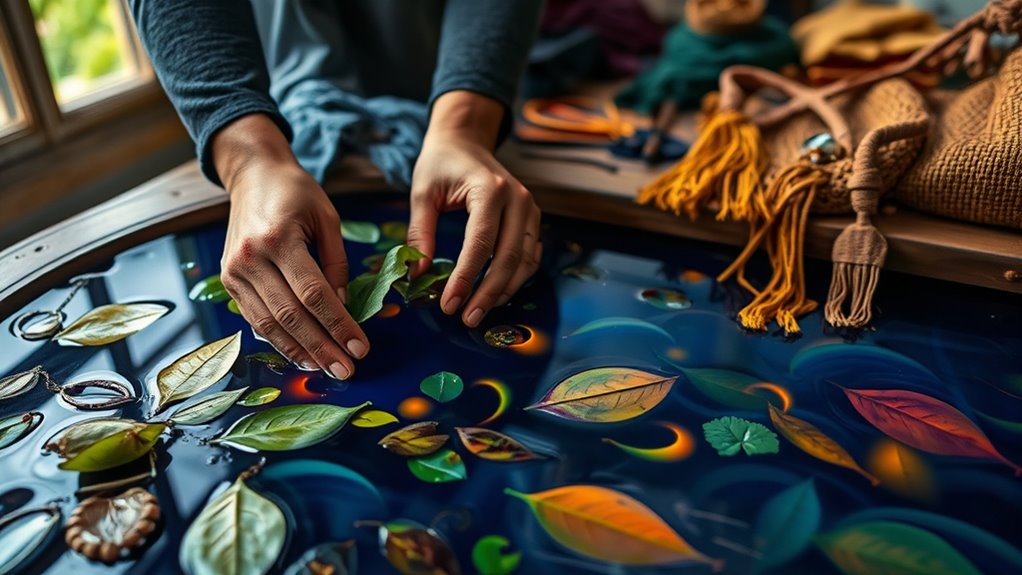
Natural dyes derived from plants and herbs offer an eco-friendly alternative to synthetic coloring methods. You can harness herbal infusions and botanical extractions to create vibrant, sustainable colors for your accessories. By soaking plant materials like indigo, madder root, or turmeric, you extract pigments that color fabrics naturally. These botanical extractions involve carefully processing plant parts to draw out their dye compounds, ensuring rich hues without harmful chemicals. Using plant-based dyes not only reduces environmental impact but also offers unique, earthy tones that synthetic dyes can’t replicate. As you explore natural dyeing, you’ll find that each botanical infusion provides a distinctive shade, giving your accessories a truly organic, sustainable appeal. This approach promotes eco-conscious craftsmanship and encourages a gentle, eco-friendly dyeing process, which can be enhanced by understanding the various dyeing techniques used in natural dyeing practices. Additionally, understanding the environmental benefits of natural dyes can further motivate sustainable practices in accessory creation. Incorporating business insights from industry trends can help artisans market their eco-friendly products more effectively and reach a wider audience. Exploring dye fixation methods can also improve colorfastness and durability of your dyed accessories, ensuring long-lasting vibrancy. When growing your own organic dye plants, you can further reduce reliance on commercial sources and create truly sustainable materials.
Waterless and Eco-Friendly Dyeing Technologies

Traditional dyeing methods often rely heavily on large amounts of water, raising environmental concerns and increasing resource consumption. Waterless and eco-friendly dyeing technologies address these issues by markedly reducing water use and waste. Techniques like vapor dyeing, foam dyeing, and digital printing not only conserve water but also lower chemical runoff, making the process cleaner. When combined with biodegradable fabrics and natural fiber treatments, these methods become even more sustainable, ensuring that dyes and textiles break down safely at the end of their life cycle. Additionally, implementing sustainable practices can further reduce the environmental impact of dyeing processes. By adopting waterless dyeing techniques, you contribute to a more sustainable accessory industry that values eco-conscious production and responsible resource management. Furthermore, advancements in dye fixation methods help improve colorfastness, reducing the need for repeated dyeing and minimizing waste. Innovations like environmentally friendly chemicals are also emerging to make the dyeing process safer for both workers and ecosystems. Embracing innovative dyeing methods can also inspire industry-wide shifts toward greener practices and innovations. Incorporating waterless dyeing techniques also encourages a shift toward circular economy principles, promoting reuse and recycling in textile production.
Use of Recycled and Upcycled Materials in Dyeing Processes
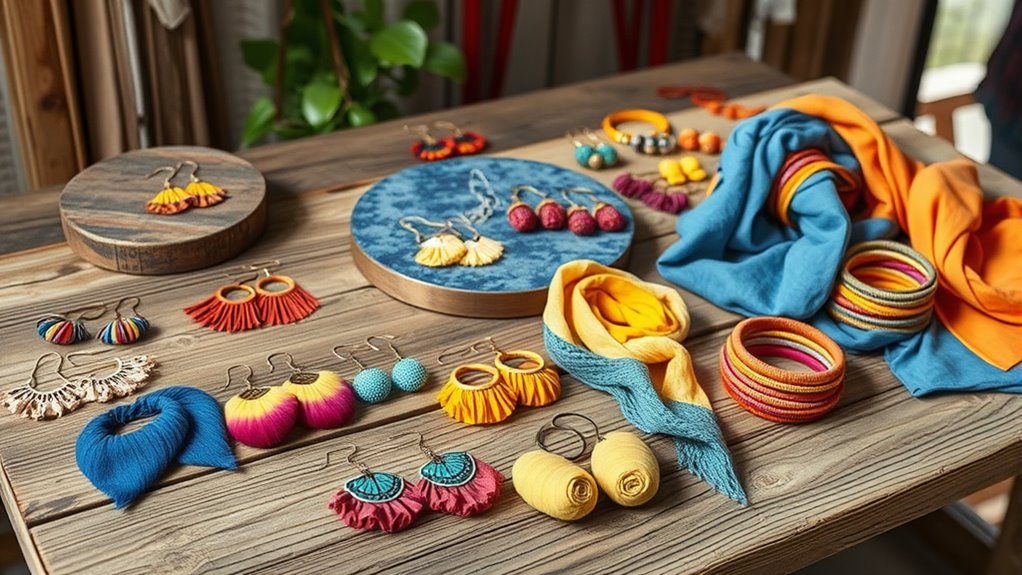
You can reduce waste and extend the life of textiles by repurposing scrap materials in your dyeing process. Using innovative blends of recycled fibers allows for unique textures and colors while minimizing environmental impact. Incorporating these approaches makes your dyeing practices more sustainable and resource-efficient. Additionally, utilizing recycled materials in dyeing not only promotes eco-friendliness but also creates distinctive aesthetic effects that enhance the appeal of your accessories. Employing energy-efficient techniques in the dyeing process further supports sustainability by reducing electricity consumption and overall resource use. Exploring sample development methods can help you optimize your sustainable practices and create a variety of designs with minimal waste. Incorporating innovative dyeing methods can also improve colorfastness and reduce chemical use, making your process even more eco-friendly. To further improve your environmental impact, consider integrating keto diet app features like carb tracking to better understand the environmental impact of your material choices.
Repurposing Textile Waste
Repurposing textile waste in dyeing processes offers a sustainable alternative to conventional methods, reducing landfill overflow and conserving resources. By transforming textile waste into vibrant dyes or raw materials, you can create eco-friendly accessories with a lower environmental footprint. Here are four ways this approach benefits your work:
- Uses discarded textile waste as a source for natural dyes, minimizing pollution.
- Enables upcycling of fabric scraps into unique, sustainable accessory designs.
- Reduces reliance on virgin materials, conserving water and energy.
- Promotes creativity by incorporating imperfect or leftover textiles into your designs. Waste reduction strategies can further optimize your sustainable practices, supported by AI-driven analytics to identify waste patterns and improve efficiency. Incorporating sustainable dyeing techniques also minimizes chemical use and environmental impact. Additionally, embracing closed-loop systems ensures that waste is continuously reused, further enhancing sustainability.
– Utilizing eco-friendly materials in your dyeing process further enhances sustainability and appeals to environmentally conscious consumers.
This method not only helps manage textile waste but also enhances your accessory design process, making your products both stylish and environmentally responsible. Embracing repurposed textile waste aligns your brand with sustainability and innovation.
Innovative Material Blends
Innovative material blends are transforming dyeing processes by incorporating recycled and upcycled materials, which reduces environmental impact and adds unique character to each piece. You can now experiment with biodegradable fibers, ensuring that the end products are eco-friendly and naturally decomposable. Natural fiber blends, such as hemp, organic cotton, and linen, create a sustainable foundation for dyeing, minimizing chemical use and waste. These blends allow for vibrant, durable colors while maintaining eco-conscious standards. By choosing recycled textiles and upcycled fabrics, you reduce landfill waste and conserve resources. This approach not only benefits the environment but also offers consumers distinctive, handcrafted accessories. Incorporating sustainable materials into dyeing techniques enhances eco-friendliness and supports responsible fashion practices. Additionally, utilizing eco-friendly dyes and finishing agents further minimizes harmful chemical exposure during the dyeing process. Embracing innovative material blends signifies a shift toward more responsible, creative dyeing techniques in the accessory industry. Moreover, the integration of plant-based fibers can improve the biodegradability and overall sustainability of the final products.
Microbial and Fermentation-Based Dye Production

Microbial and fermentation-based dye production harnesses microorganisms such as bacteria, fungi, and algae to generate natural colorants sustainably. Using genetic engineering, you can enhance these microbes’ ability to produce specific dyes efficiently. Microbial fermentation allows you to cultivate these organisms in controlled environments, reducing reliance on traditional farming methods.
Here are key benefits:
- Customizable colors through genetic modifications
- Lower environmental impact compared to synthetic dyes
- Faster production cycles with optimized fermentation processes
- Reduced water and chemical usage in dye manufacturing
This innovative approach makes dye production more eco-friendly and scalable, aligning with sustainable industry goals. By embracing microbial and fermentation techniques, you contribute to a greener accessory industry with vibrant, natural hues.
Digital and Precision Dyeing for Reduced Waste
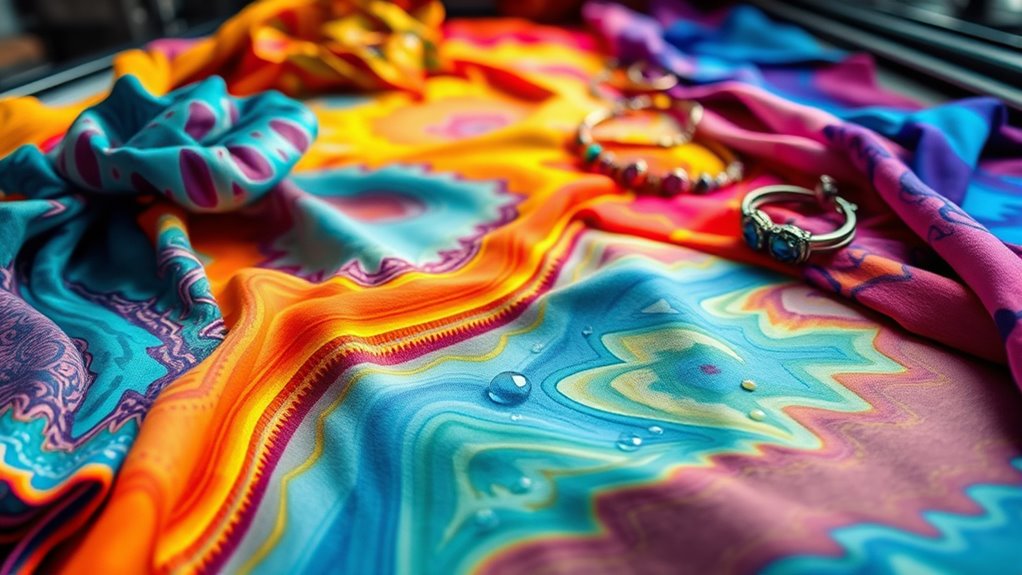
Digital and precision dyeing techniques help you cut water use considerably while achieving more accurate and vibrant colors. By controlling dye application precisely, you reduce waste and avoid over-dyeing. This approach makes your process more sustainable and cost-effective.
Minimized Water Usage
Minimized water usage in dyeing processes has become increasingly achievable through digital and precision dyeing techniques. These methods enhance dyeing efficiency and promote water conservation, reducing environmental impact. By targeting specific areas and applying dye precisely, you can cut down water use markedly. Here are four key benefits:
- Less water needed for each batch, lowering overall consumption.
- Fewer wash cycles, decreasing wastewater generation.
- Accurate dye application, minimizing excess dye runoff.
- Reduced need for extensive rinsing, saving water and resources.
Adopting these innovative techniques helps you contribute to a more sustainable accessory industry while maintaining high-quality dyeing results. Digital and precision dyeing are transforming traditional practices, making water conservation more practical and effective.
Enhanced Color Accuracy
By harnessing advanced digital and precision dyeing techniques, you can achieve considerably improved color accuracy in your dyeing processes. This leads to better color consistency across batches, ensuring each accessory looks vibrant and true to design. With higher dye fidelity, you reduce the chances of miscoloring and waste caused by mismatched shades. Digital dyeing allows you to precisely control pigment application, minimizing over-dyeing and excess use of resources. Precision techniques ensure that each piece receives the exact amount of dye needed, cutting down on leftover dyes and reducing environmental impact. Overall, enhanced color accuracy not only elevates product quality but also supports sustainable practices by decreasing waste, making your accessory line more eco-friendly and reliable.
Solar-Powered and Energy-Efficient Dyeing Methods
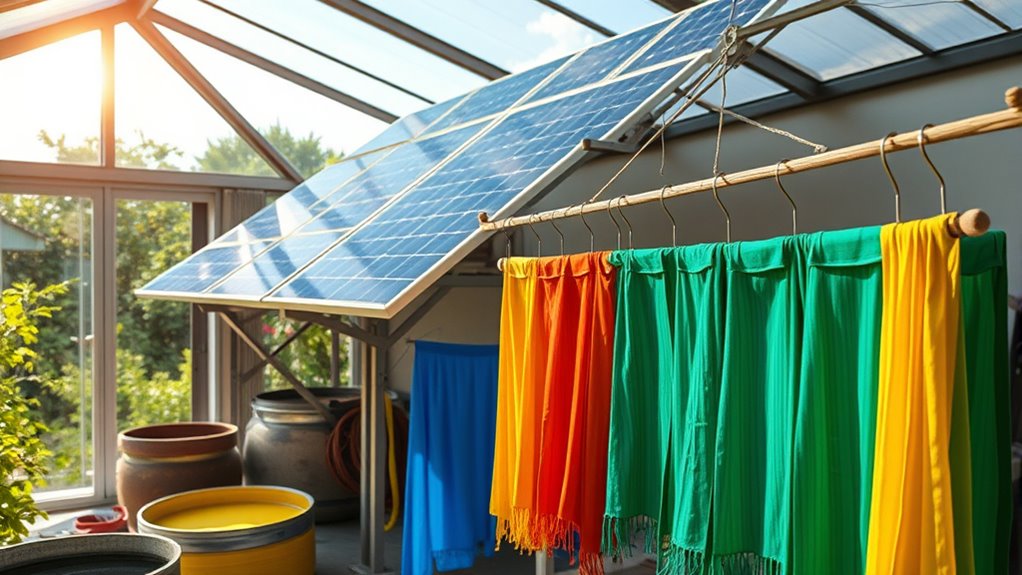
Harnessing solar power and optimizing energy use are transforming dyeing processes into more sustainable practices. By leveraging solar energy, you reduce reliance on fossil fuels, lowering carbon footprints. Energy efficiency also plays a vital role in minimizing waste and conserving resources. Here are four ways you can implement these methods:
- Install solar panels on dyeing facility roofs to power equipment with clean energy.
- Use energy-efficient dyeing machines that consume less power and water.
- Integrate automated systems to optimize dyeing cycles, reducing energy waste.
- Incorporate heat recovery systems to reuse excess heat, enhancing overall efficiency.
Adopting these techniques helps you make dyeing more eco-friendly, aligns with sustainable goals, and can even cut costs over time.
Innovative Dyeing Techniques Using Mineral and Clay-Based Pigments
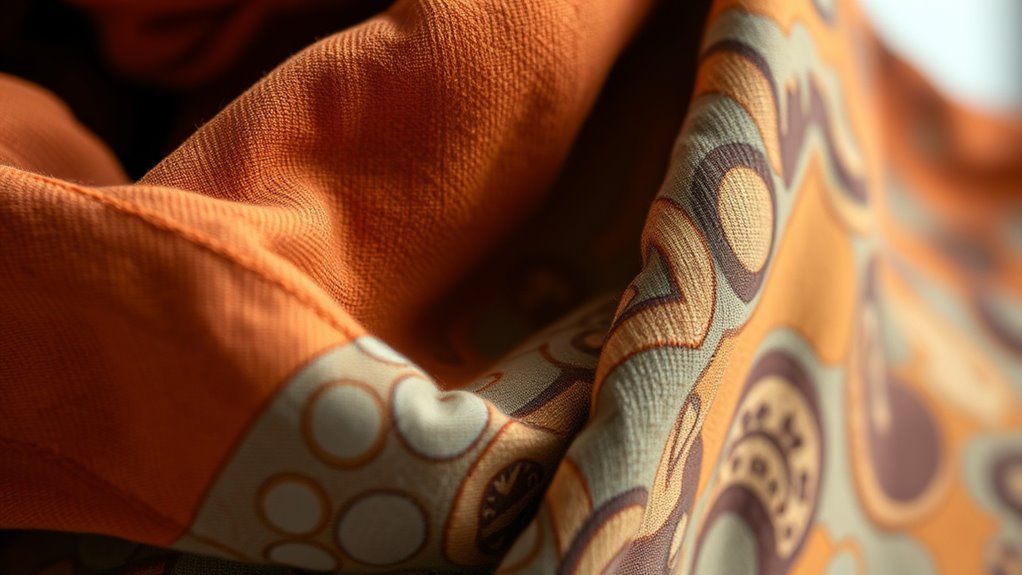
Mineral and clay-based pigments offer several advantages, including natural color richness and durability. They provide excellent color stability, ensuring your fabrics stay vibrant over time. Plus, these eco-friendly dyes minimize environmental impact, making your dyeing process more sustainable.
Mineral Pigment Advantages
Using mineral and clay-based pigments offers significant advantages in sustainable dyeing techniques. These mineral pigment advantages include their natural mineral coloring, which provides vibrant, long-lasting hues without synthetic chemicals. They are non-toxic and safe for both artisans and consumers, reducing environmental impact. Additionally, mineral pigments are highly stable, resisting fading over time, making them ideal for durable accessories. They also require less water and energy during production compared to conventional dyes, decreasing resource consumption.
- Natural mineral coloring ensures vivid, lasting shades.
- Non-toxic and eco-friendly for safer production.
- High stability prevents fading and maintains color integrity.
- Lower resource use minimizes environmental footprint.
Embracing mineral pigments helps you create sustainable accessories that are both beautiful and responsible.
Clay-Based Color Stability
Building on the benefits of mineral pigments, clay-based dyes offer remarkable color stability that enhances the longevity of your creations. Clay-based color stability guarantees your accessories resist fading over time, maintaining vibrant hues even after extensive use. This durability stems from the mineral pigment advantages, as clay particles bond tightly with natural fibers, creating a resilient dyeing effect. Unlike synthetic dyes, clay-based pigments are less prone to environmental degradation, making your products more sustainable and long-lasting. Their inherent stability means your designs will retain their original brilliance, reducing the need for frequent re-dyeing or touch-ups. By choosing clay-based color stability, you benefit from eco-friendly, reliable, and enduring colors that elevate both the quality and sustainability of your accessories.
Eco-Friendly Dyeing Processes
Innovative dyeing techniques harness the natural properties of mineral and clay-based pigments to create eco-friendly processes that reduce environmental impact. Unlike synthetic dyes, these methods minimize water use and avoid toxic chemicals, making them safer for the environment. They also enhance dye colorfastness, ensuring your accessories stay vibrant longer. Here are some key points:
- You can use mineral pigments derived from earth minerals, which are non-toxic and sustainable.
- Clay-based dyes offer natural color options without relying on synthetic dyes, reducing chemical runoff.
- These processes often require less water and energy, lowering overall ecological footprints.
- The resulting colors tend to be more stable and durable, improving dye colorfastness without synthetic additives.
Low-Impact Synthetic Dyes With Reduced Chemical Use
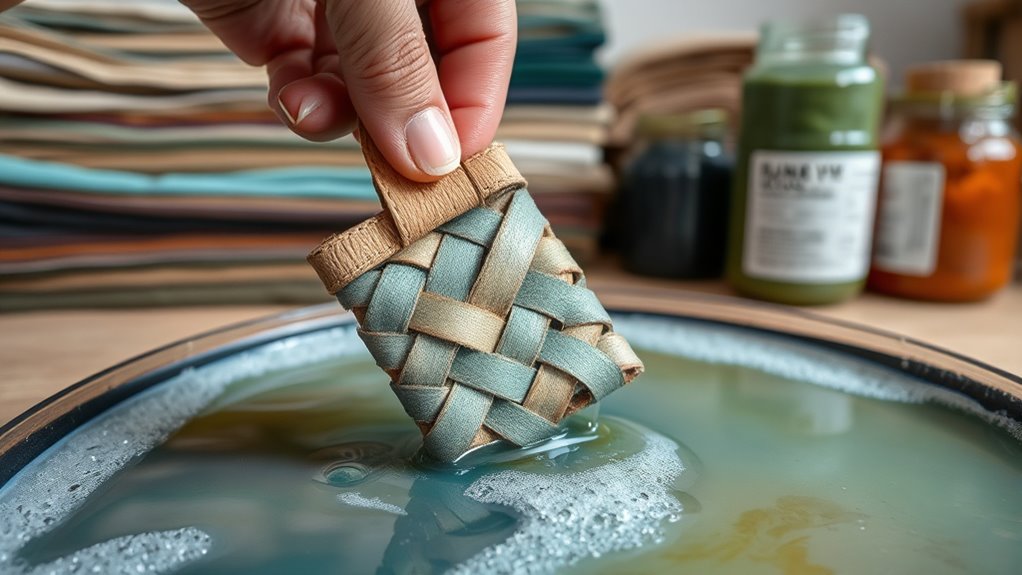
Despite their widespread use in the textile industry, traditional synthetic dyes often pose significant environmental and health risks due to their high chemical content. Low-impact synthetic dyes focus on enhancing synthetic dye safety by reducing harmful chemicals during production and application. These dyes utilize innovative formulas that lower chemical use without sacrificing color vibrancy. You can choose dyes that are more sustainable, minimizing pollution and health hazards. Here’s a quick comparison:
| Feature | Traditional Synthetic Dyes | Low-Impact Synthetic Dyes |
|---|---|---|
| Chemical Use | High | Reduced |
| Environmental Impact | Significant | Minimal |
| Dye Fastness | Similar | Similar |
Integration of Closed-Loop Systems in Dyeing Operations
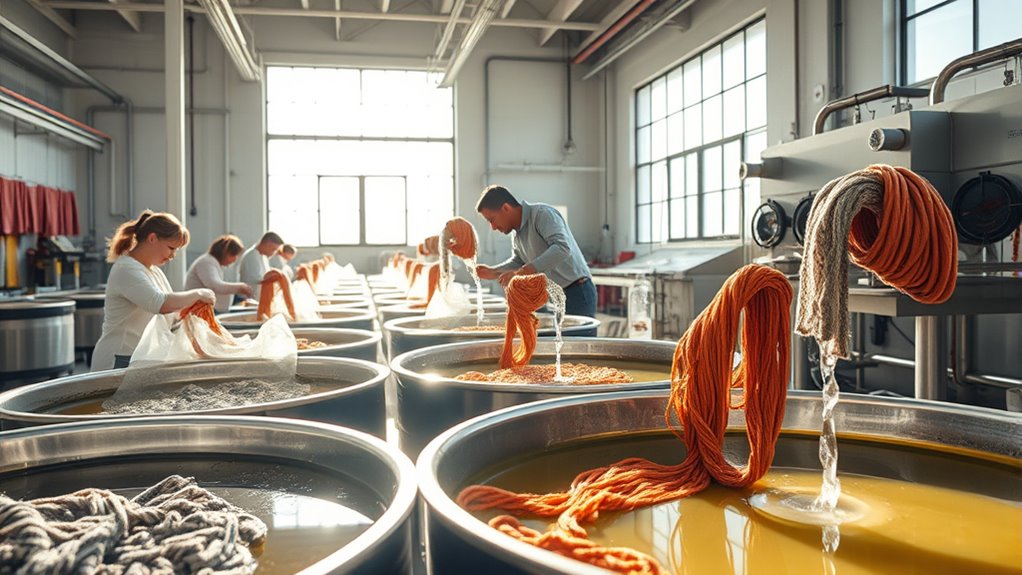
Integrating closed-loop systems into dyeing operations offers a practical way to considerably reduce water and chemical waste, building on the advances made with low-impact synthetic dyes. By adopting these systems, you support a circular economy, where waste is minimized and resources are reused. This enhances waste management efficiency and reduces environmental impact. Here are four key benefits:
- Recycles water and chemicals, lowering overall consumption
- Prevents wastewater discharge, protecting ecosystems
- Improves resource efficiency, reducing raw material use
- Promotes sustainable growth within the accessory industry
Through closed-loop systems, you help create a more sustainable dyeing process, aligning your practices with eco-conscious goals and responsible waste management. This approach not only benefits the environment but also boosts your brand’s appeal to eco-aware consumers.
Collaborations and Innovations Driving Sustainable Dyeing Practices
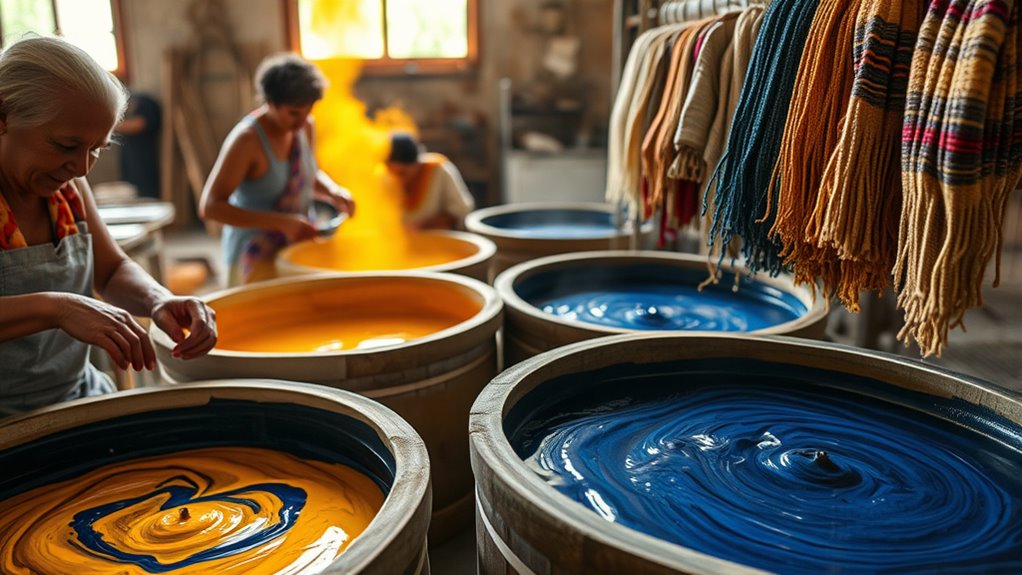
Collaborations between industry leaders, research institutions, and startups are accelerating the development of sustainable dyeing solutions. These partnerships foster dyeing experimentation, blending traditional artisanal craftsmanship with innovative techniques. By working together, you can access new eco-friendly dyes derived from botanical extracts or waste materials, reducing reliance on harmful chemicals. Such collaborations also inspire artisans to refine their craft with sustainable practices, ensuring that artisanal craftsmanship thrives alongside environmental goals. Innovations like bio-based dyes or low-water dyeing methods emerge from these joint efforts, pushing boundaries in the accessory industry. As a result, you benefit from more sustainable options that maintain quality and artistry, making eco-conscious choices more accessible without sacrificing craftsmanship or style.
Frequently Asked Questions
How Do Natural Dyes Compare in Color Fastness to Synthetic Dyes?
Natural dyes often have less color fastness compared to synthetic dyes, meaning their vibrant hues may fade faster with washing or exposure to sunlight. You might notice that synthetic dyes provide more consistent, durable color retention over time. However, natural dyes are eco-friendly and less harsh on the environment. While they may require more careful handling, their unique, organic shades make them a popular choice for sustainable accessories.
What Are the Challenges of Scaling Eco-Friendly Dyeing Methods Commercially?
You might wonder what hurdles eco-friendly dyeing faces when scaling up. The challenge lies in balancing cost analysis and maintaining quality, which can drive prices higher. Additionally, a complex supply chain complicates sourcing sustainable materials consistently. As you push for greener methods, expect unpredictable factors like limited supplier options and the need for specialized equipment. Overcoming these obstacles requires strategic planning and commitment to sustainable growth.
How Do Microbial Dyes Impact the Durability of Finished Accessories?
Microbial dyes can impact the durability of your accessories through their microbial dye stability. When these dyes are stable, they resist fading and degradation over time, enhancing accessory longevity. However, if microbial dye stability is compromised, your accessories might lose color faster, reducing their lifespan. Proper application and formulation ensure microbial dyes provide vibrant, lasting color, making your accessories more durable and eco-friendly without sacrificing quality.
Are There Certifications for Sustainable Dyeing Practices in the Industry?
You might wonder if there are certifications for sustainable dyeing practices. Yes, the industry has certification programs that set standards for eco-friendly dyeing methods, ensuring practices are environmentally responsible. These certifications, like GOTS or OEKO-TEX, help you identify brands committed to sustainable industry standards. They verify that dyes are eco-conscious, reducing harmful chemicals and water usage, making it easier for you to choose accessories that align with your sustainability values.
How Do Consumer Perceptions Influence the Adoption of Sustainable Dyeing Techniques?
You see, consumer perceptions play a big role in the adoption of sustainable dyeing techniques. When you prioritize environmental awareness and seek products that align with your values, you boost consumer trust in brands that use eco-friendly methods. Your demand for transparency encourages companies to adopt sustainable practices, creating a positive cycle. By choosing eco-conscious accessories, you’re helping to drive industry change and support more environmentally responsible dyeing techniques.
Conclusion
By embracing these innovative dyeing techniques, you can transform the accessory industry into a more sustainable space. Imagine a brand that switches to plant-based dyes, reducing chemical waste and appealing to eco-conscious consumers. This shift not only benefits the environment but also sets you apart in a competitive market. As more designers adopt waterless and microbial dyeing methods, you’ll see how small changes can lead to a significant, positive impact on our planet.
